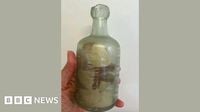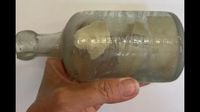On a sunny October day in 2025, the Brown family set out on one of their regular quad bike expeditions along Wharton Beach, near Esperance in Western Australia. Their mission was simple: clear the coastline of rubbish, a habit that had become second nature over many years. But this time, their routine clean-up uncovered something extraordinary—a Schweppes-brand glass bottle, thick and clear, lying just above the waterline. What seemed at first like another piece of flotsam turned out to be a time capsule, holding inside it messages from the distant past: two letters written in pencil by Australian soldiers Malcolm Neville and William Harley, dated August 15, 1916.
According to BBC and the Associated Press, the letters were penned just a few days into the soldiers’ voyage from Adelaide. Their troop ship, HMAT A70 Ballarat, had left South Australia on August 12, 1916, carrying reinforcements for the 48th Australian Infantry Battalion to the Western Front in Europe. The men, Private Malcolm Neville, 27, and Private William Harley, 37, wrote with a surprising sense of cheerfulness and hope, despite the uncertainty that lay ahead.
Inside the bottle, Neville’s letter was addressed to his mother, Robertina Neville, in Wilkawatt—a now nearly forgotten town in South Australia. He wrote, “having a real good time, food is real good so far, with the exception of one meal which we buried at sea.” He described the ship as “heaving and rolling, but we are as happy as Larry,” using a colloquialism that, though faded now, meant they were in high spirits. Neville ended his note with the location, “Somewhere at Sea,” a poignant reminder of the vast unknown before him.
Harley’s letter, on the other hand, was addressed simply to the finder. His mother had passed away before 1916, so he left his message for whoever might discover it. “May the finder be as well as we are at present,” he wrote, noting their position as “Somewhere in the Bight”—a reference to the sweeping Great Australian Bight that stretches from east of Adelaide to the coast near Esperance. Harley, unlike Neville, would survive the war, though not unscathed; he was wounded twice and later died in 1934 in Adelaide, from cancer his family believes was caused by being gassed in the trenches.
The discovery of the bottle, as reported by the Associated Press, was made possible by the Brown family’s dedication to keeping their local beaches clean. Deb Brown recalled, “We do a lot of cleaning up on our beaches and so would never go past a piece of rubbish. So this little bottle was lying there waiting to be picked up.” The bottle itself was in pristine condition, with no barnacle growth or signs of long-term exposure to the elements. This, Deb suspects, means it spent most of the last century buried in the sand dunes, only recently dislodged by the massive swells and erosion that have battered Wharton Beach in recent months.
Despite the paper being wet, the writing inside remained legible. This remarkable preservation allowed Deb Brown to embark on a new mission: tracking down the soldiers’ descendants. Using the information in Neville’s letter, she located his great-nephew, Herbie Neville, by searching for the family name and the town online. She also connected with Harley’s granddaughter, Ann Turner, and other relatives. Brown plans to mail the letters back to the soldiers’ families, keeping the bottle and Neville’s cover letter as mementos of this extraordinary find.
The impact on the families has been profound. Ann Turner told the Australian Broadcasting Corporation, “We just can’t believe it. It really does feel like a miracle and we do very much feel like our grandfather has reached out for us from the grave.” For Neville’s family, the discovery brought together relatives who had long been separated by time and distance. Herbie Neville described the experience as “unbelievable,” adding, “It sounds as though he was pretty happy to go to the war. It’s just so sad what happened. It’s so sad that he lost his life. Wow. What a man he was.”
The letters themselves offer a rare, unfiltered glimpse into the mindset of young men on the cusp of war. Neville’s optimism and humor, even as his ship lurched across the open ocean, stand in stark contrast to his fate—he was killed in action in France in April 1917, just months after writing the letter. Harley’s note, meanwhile, is imbued with a quiet resilience. Though he survived the war, his life was irrevocably changed by the horrors he endured.
Experts believe the bottle’s journey was relatively short. An oceanography professor told ABC that it may have spent only a few weeks in the water before washing ashore at Wharton Beach, where it likely remained buried for over a century. This theory is supported by the bottle’s immaculate condition and the legibility of the letters. Had the bottle spent decades at sea or exposed to the sun, the paper would almost certainly have disintegrated.
For Deb Brown and her family, the discovery has been nothing short of magical. “It’s absolutely wonderful,” she told reporters. “We get to keep the bottle, and Malcolm’s cover letter that was addressed to the finder.” The family’s commitment to environmental stewardship not only helped preserve their local coastline but also unearthed a tangible link to Australia’s wartime past—one that has now been shared with the world and, most importantly, with the families of the men who wrote those words more than a hundred years ago.
The story of the Wharton Beach bottle is more than just a tale of chance discovery. It’s a testament to the enduring power of human connection, the resilience of memory, and the unexpected ways in which history can reach out to us across the decades. As the letters are returned to the descendants of Neville and Harley, they serve as a reminder that the past is never truly lost—it just waits, sometimes buried in the sand, for the right hands to bring it back to light.


